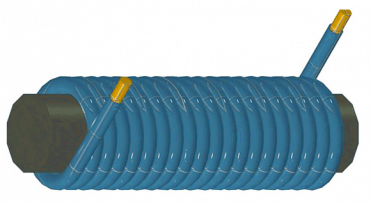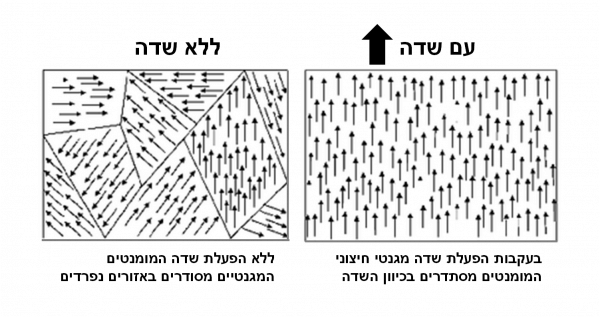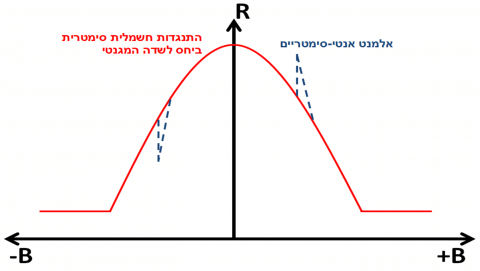Oren Shaya, the owner of the blog "To a constant extent" met with Amir Segal to ask him what they are doing there at the university. First episode in the series

Amir is originally from Jerusalem and currently lives with his wife and daughter in Modi'in. He is a guitarist in the band 'Kobayashi Porcelain'. He earned his first degree at the Hebrew University and is currently finishing his doctoral thesis in physics at the spintronics and high magnetic fields laboratory of Prof. Alexander Gerber at Tel Aviv University.
Amir, so what are you doing there?
We are interested in investigating and understanding the effect of magnetic fields on the electrical conduction of materials in thin layers. To that end, we have the strongest magnet in the Middle East in the lab, at least according to the last time I checked. It is an electromagnet which is actually a metallic coil similar in shape to a spring (see figure). When an electric current is passed through it, a uniform magnetic field is created inside the cylindrical space. In order to perform a measurement, the model, which you wish to investigate, is inserted into the coil cavity. By changing the current, the strength of the magnetic field can be controlled with great precision, and check how the change affects the electrical conductivity of the material being tested.
The main materials we are researching are ferromagnetic materials and superconducting materials. Superconductors are materials that, if cooled below a certain temperature (the critical temperature), their electrical resistance drops to zero. For example, lead goes into a superconducting state at a temperature of 7.19 degrees above absolute zero (ie -266 degrees Celsius). In this special mode there is no waste of energy during the flow of electricity in the model and it can, theoretically, last forever.
The phenomenon was discovered as early as 1911, but only in the 50s did they manage to find an explanation for it. The explanation is related to the fact that the electrons participating in electrical conduction are arranged in pairs, and between the special pairs of electrons there is attraction instead of repulsion. This explanation earned Hugo the Nobel Prize in Physics. In the 80s there was another interesting development, when a family of materials was discovered in which the transition to the superconducting state occurs at relatively high temperatures, some above the temperature of liquid nitrogen. There is no satisfactory explanation for this phenomenon to this day.
And what are ferromagnetic materials?
In every material there are microscopic magnetic elements called the magnetic moments. Electrons, for example, carry this property that stems from their spin. The magnetic moments in ferromagnetic materials tend to line up in the same direction. Materials where all the magnetic moments point in the same direction will be magnetic and we can, for example, stick them to the refrigerator.
So why is iron, which is a ferromagnet, not always magnetic?
Because the steady state of the magnetic moments depends on many parameters. Typically, the magnetic moments will be aligned in the same direction in limited regions a few microns in length. Each such area will point to a different location, so the entire piece of material will not be magnetic. We can invest energy and make all the torques point in the same direction, for example by activating an external magnetic field, and then the material will become a permanent magnet (see figure).
Why are these materials interesting?
For two main reasons: the first reason is that they can have technological applications that we may get to later. The second reason is that although these substances have been known to science for many years, many things about the physics that dictate these phenomena are not understood.
So what did you want to test in your laboratory?
One of the projects I worked on was investigating a mixture of ferromagnetic and superconducting materials.
Why?
Because there is something in them that is fundamentally contradictory. The special electron pairs that participate in conduction in a superconducting material consist of two electrons that have a magnetic moment in opposite directions. On the other hand, as I mentioned before, in ferromagnetic materials the tendency of the magnetic moments is to line up in the same direction. A pair of electrons from the superconductor that suddenly finds itself in a ferromagnetic material, may 'feel uncomfortable'. We wanted to know how the material would behave in this situation.
And what did you find out?
Unfortunately, not much at first. It turns out that when we mixed the materials we used, ferromagnetic nickel and superconducting lead, a mixture of nickel grains, lead grains and grains of a compound between nickel and lead was obtained. The formation of the compound was not expected and prevented us from reaching clear conclusions about the subject we wanted to test.
We tried to overcome the problem with all kinds of methods and it didn't exactly work. But while we were working on solving the problem, we encountered an equally interesting phenomenon. Something unexpected appeared both in the measurement of superconductors and ferromagnets, and indicated some connection between them.

what did you see
When measuring the resistance of a ferromagnetic material as a function of the magnetic field, the result is always symmetrical. The intention is that the electrical resistance of the material in a certain magnetic field will remain the same if we reverse the direction of the field (see figure). In the measurements we performed in the laboratory, a result was obtained that includes an antisymmetric element in addition to the symmetric signal that we are used to finding. The antisymmetric signal appeared at the point where the magnetization of the model reverses.
At the same time, we found a similar but opposite phenomenon in superconductors. For an antisymmetric phenomenon with respect to the magnetic field (Hall voltage) a symmetric element was added in the region of the transition to the superconducting state.
So what is the connection between the two phenomena? After all, these are completely different materials.
True, but what links the two results is the breaking of the symmetry. Something was added to the physical system and added a different directionality than expected. This could be, for example, inhomogeneity of the material. In the production process of the model, all kinds of defects can be caused, such as non-uniformity in thickness or penetration of foreign atoms. These 'disturbances' may cause, for example, local changes in the conditions in which the material goes from a normal state to a superconducting state. This will cause certain areas of the material to be superconducting at the same time that other areas will not be in this state, which will cause a diversion of the electric flow and different internal voltages, as observed in my experiments.
Ok, interesting explanation. But, how did you check if the phenomenon he describes actually exists in reality?
We simply produced models where there was an inhomogeneity that we initiated such as a gradual change in thickness or a change in the type of material. For these cases we could use our model to try to predict the result of the inhomogeneity and confirm it in experiments on these models.
Then summarize the relationship between the two types of materials.
In both types of materials, superconductors and ferromagnets, there are critical points that are related to the magnetic field and cause large changes in electrical conduction. In superconductors it is the transition to the superconducting state and in ferromagnets it is the reversal of the magnetization direction. The lack of homogeneity causes spatial changes in the properties of the material. Around the critical points, these changes are manifested and cause the symmetry to be broken, which is actually what we saw in the experiment.
So what's the next step?
For this project, we decided to try a more applied course of action. We have some ideas on how to exploit inhomogeneity to design more efficient magnetic memory components than existing ones. We are currently working on them, and maybe one day they will be able to compete with the popular flash memories.

---------------------------
I would be happy to meet and talk with any research student (maybe you?) who is willing to participate and tell me a little about what he is doing (and all for the price of a not too long conversation). You can contact me through the contact form.

2 תגובות
Nice idea (both the topic of the article and the general idea of talking to students)
I think your posts will be a great contribution to the nanotech section of "Hayadan".
Perhaps also an interview with a Catalan?